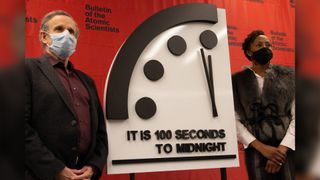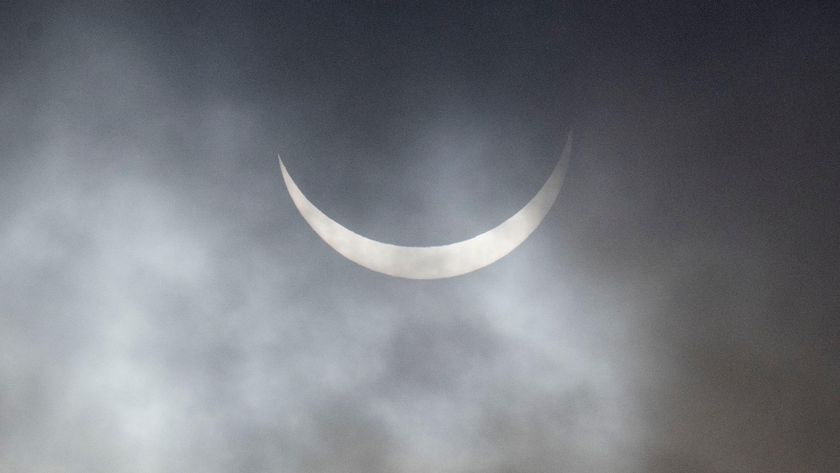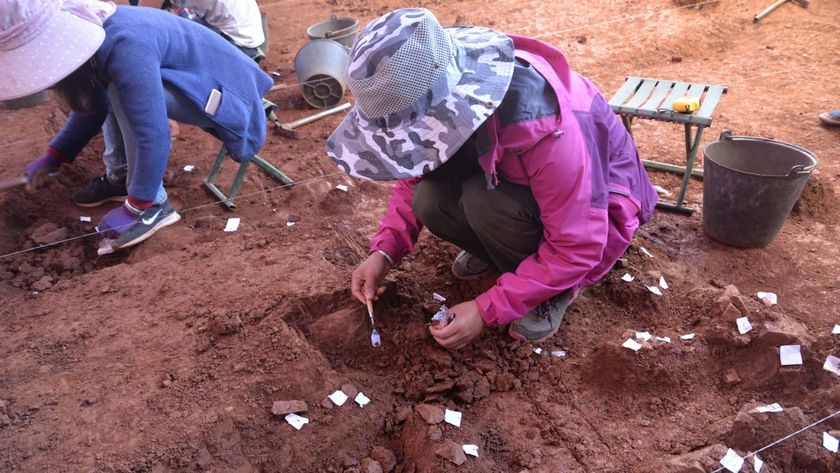Doomsday Clock stands at 100 seconds to midnight
Our destruction is close, but it creeps no closer ... for now.

Nuclear weapons, global pandemics, accelerating climate change: Is humanity running out of time? Despite 2020's general awfulness, humanity paused on the path forward to armageddon — at least, according to the Doomsday Clock, a hypothetical timepiece that annually assesses our nearness to utter annihilation.
This year, the Doomsday Clock's hands will not be moving forward, and it continues to show the same time that was set last year: 100 seconds to midnight, the Bulletin of the Atomic Scientists (BAS), a global organization of science and policy experts, announced at a virtual press event on Weds. (Jan. 27).
The bad news is that we're still closer to midnight than we've been at any time since the clock was introduced more than 60 years ago. With widespread mishandling of the COVID-19 pandemic in nations worldwide; little progress in eliminating nuclear weapons; and insufficient mitigation of destructive climate change, the BAS decided to hold the clock at the present, perilous time, as a warning and "wake-up call," BAS representatives said in a statement.
Related: The top 10 ways to destroy planet Earth
COVID-19 was a newcomer to the list of challenges humanity faced in 2020, and though efforts are underway to bring the novel coronavirus under control, its swift and deadly spread demonstrated that many nations were ill-equipped to deal with serious global health emergencies, Rachel Bronson, BAS president and CEO, said at the press event.
"Governments around the world abdicated their responsibility, did not cooperate, and consequently failed to protect the health and welfare of their citizens," Bronson said. While COVID will recede eventually, it still serves "as a historic wakeup call," showing that officials are woefully unprepared to handle pandemics that could arise in the future, Bronson said.
Global carbon emissions, a major driver of human-induced climate change, temporarily dropped about 17% due to the pandemic, "but have largely bounced back," said Susan Solomon, a professor of environmental studies at the Massachusetts Institute of Technology (MIT), and a BAS Science and Security Board member. By the end of 2020, emissions were only about 4% lower than the year before, "and are expected to increase as the world emerges from the pandemic," Solomon said at the press event. In any case, pandemic-induced reductions in emissions isn't a sustainable plan for the future, Solomon added.
Sign up for the Live Science daily newsletter now
Get the world’s most fascinating discoveries delivered straight to your inbox.
One of humanity's biggest and longest-standing existential risks — nuclear weapons — remained "unacceptably high," with the United States relegating more than a trillion dollars to modernizing and developing its nuclear weapons programs, said BAS board member Steve Fetter, a professor of public policy at the University of Maryland. Russia maintains nearly 1,000 nuclear weapons "that could be launched in minutes," and nations such as China, India, North Korea and Pakistan continue to expand their arsenals, Fetter added.
"The modernization and expansion of nuclear arsenals in multiple countries, combined with the lack of diplomatic efforts to reduce nuclear risks, have increased the likelihood of catastrophe," he said in the statement. "By our estimation, the potential for the world to stumble into nuclear war — an ever-present danger over the last 75 years — increased in 2020."
Creeping forward
To decide the clock's time each year, the BAS's Science and Security Board consults with the Bulletin's Board of Sponsors —13 of whom are Nobel Laureates — to assess threats that loom large on the global stage. Recent years have seen alarming forward momentum in the clock's proximity to midnight.
In 2018, the clock's minute hand ticked forward to stand at two minutes to midnight — the last and only time they had previously come that close was in 1953, when tensions between the United States and the former Soviet Union were climbing and both global superpowers had conducted the first hydrogen bombs detonations, barely six months apart.
Doomsday Clock time stood still in 2019, but ticked forward again in 2020, to reflect that humanity faces "a true emergency — an absolutely unacceptable state of world affairs that has eliminated any margin for error or further delay," Bronson said in a statement that year.
Though the hands of the Doomsday Clock remain static — for now — existential threats to humanity continue to advance, said Nobel Peace Prize winner Ellen Johnson Sirleaf, former president of Liberia and co-chair of the World Health Organization.
"What we have all endured over the past year shows that we cannot afford to waste any more time," Sirleaf said at the press event. "Future generations will neither understand nor forgive further inaction under such grave threats."
Related: 5 Mayan apocalypse myths debunked
When the Doomsday Clock debuted on the cover of the BAS's magazine in 1947, its minute hand was positioned at seven minutes to midnight. At the time, nuclear weapons were thought to be humanity's biggest threat. Though the number of nuclear weapons in military stockpiles has declined worldwide since the Cold War, global inventories show that approximately 13,410 warheads remain, the Federation of American Scientists (FAS) reported in Sept. 2020. Of those warheads, about 91% belong to the U.S. and Russia, FAS says.
Today, BAS researchers consider additional potential triggers for planetwide catastrophe, such as climate change; disruptive technologies; and the widespread use of social media platforms that fuel misinformation's rapid spread and erode trust in the media and in science.
In the U.S. and elsewhere in the world, far-right extremism emerged in 2020 as a growing source of terrorist violence and social disruption. Experts must now consider that groups embracing radical right-wing ideologies could constitute a significant threat to U.S. national security, BAS representatives wrote on Jan. 14.
"These extremists represent a unique danger because of their prevalence in federal institutions such as the military and the potential that they might infiltrate nuclear facilities, where they could access sensitive information and nuclear materials," BAS representatives said. "Officials need to act decisively to better understand and mitigate this threat."

Infectious disease also roared to the forefront during 2020. To date, COVID-19 has infected more than 99 million people worldwide and has killed more than 2 million, according to the Johns Hopkins University of Medicine's Coronavirus Resource Center. More than 25 million cases have been reported in the U.S. alone, and over 400,000 American people have died of the coronavirus to date.
Alongside COVID-19, the impacts of escalating climate change led NASA scientists to declare 2020 the hottest year on record, tying with 2016. Earth's average global temperatures have risen 2 F (1.2 C) since the 1880s, and annual global surface temperatures for the past 44 years have been higher than the 20th-century average. In 2020, Arctic sea ice cover plummeted to record lows; Australia lost more than 20% of its forests during a record-breaking wildfire season; and the Atlantic hurricane season was one of the most intense and busiest on record, with a record 30 named storms.
As dire as all of this sounds, these challenges are human-made — and solutions to them will likewise come from collective human efforts, ingenuity and will, BAS members said at the press event.
"Today we have the opportunity for a global reset, to admit and learn from past mistakes and to better prepare ourselves for future threats," whether from nuclear confrontations, climate change, pandemics "or a mixture of all of these," Sirleaf said.
"I hope we do more than just look at the clock and get on with our day," added BAS board member Asha George, executive director of the Bipartisan Commission on Biodefense.
"I hope we act to bring those hands back further and further, and make the world a safer place," George said.
Originally published on Live Science.

Mindy Weisberger is an editor at Scholastic and a former Live Science channel editor and senior writer. She has reported on general science, covering climate change, paleontology, biology and space. Mindy studied film at Columbia University; prior to Live Science she produced, wrote and directed media for the American Museum of Natural History in New York City. Her videos about dinosaurs, astrophysics, biodiversity and evolution appear in museums and science centers worldwide, earning awards such as the CINE Golden Eagle and the Communicator Award of Excellence. Her writing has also appeared in Scientific American, The Washington Post and How It Works Magazine. Her book "Rise of the Zombie Bugs: The Surprising Science of Parasitic Mind Control" will be published in spring 2025 by Johns Hopkins University Press.











